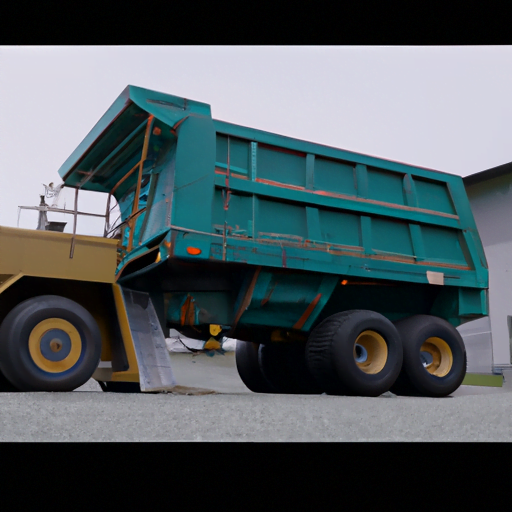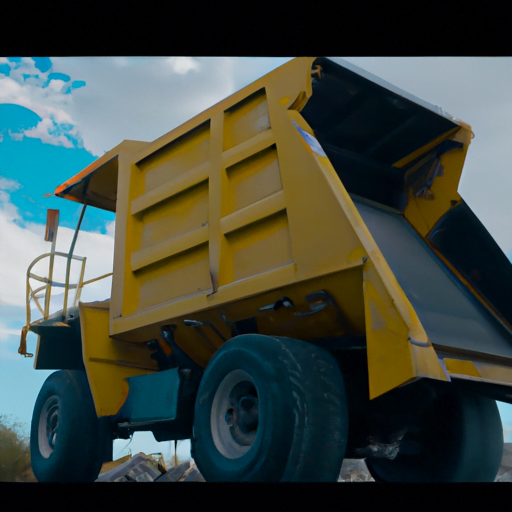-
Table of Contents
Call to action: Discover the evolution of dump trailers from past to present today!
Introduction
Dump trailers have come a long way since their inception. From the early days of manual dumping to the modern hydraulic systems, dump trailers have evolved to become more efficient and versatile. In this article, we will explore the evolution of dump trailers from the past to the present and look at what the future holds for this essential piece of equipment.
The History of Dump Trailers: Tracing the Evolution from the Past to the Present
Dump trailers have been around for centuries, and they have come a long way since their inception. These trailers have been used for various purposes, including transporting goods, construction materials, and waste. The evolution of dump trailers has been a fascinating journey, and it is interesting to see how they have changed over time.
The earliest dump trailers were simple carts that were pulled by horses or oxen. These carts were used to transport goods and materials, and they were often made of wood. The carts had a simple mechanism that allowed them to be tipped over, which made it easier to unload the goods. These carts were not very efficient, and they were often difficult to maneuver.
In the early 1900s, dump trailers started to become more advanced. The first hydraulic dump trailer was invented in 1904, and it revolutionized the way goods were transported. The hydraulic system allowed the trailer to be lifted and tilted, which made it easier to unload the goods. This innovation made dump trailers more efficient and easier to use.
In the 1920s, dump trailers started to become more popular in the construction industry. They were used to transport construction materials, such as gravel, sand, and concrete. The trailers were also used to transport waste from construction sites. This made the construction process more efficient, as it eliminated the need for manual labor to move heavy materials.
In the 1950s, dump trailers became even more advanced. The first aluminum dump trailer was invented in 1954, and it was much lighter than the previous models. This made it easier to transport goods and materials, as the trailer was not as heavy. The aluminum dump trailer was also more durable than the previous models, which made it a popular choice for construction companies.
In the 1980s, dump trailers started to become more specialized. There were dump trailers designed specifically for transporting waste, and there were dump trailers designed for transporting heavy equipment. These specialized trailers made it easier to transport specific types of goods and materials, which made the process more efficient.
Today, dump trailers are more advanced than ever before. They are made of high-quality materials, such as steel and aluminum, which makes them more durable and long-lasting. They are also equipped with advanced hydraulic systems, which make it easier to lift and tilt the trailer. Dump trailers are now used in a variety of industries, including construction, agriculture, and waste management.
In the future, dump trailers are expected to become even more advanced. There are already prototypes of dump trailers that are equipped with advanced technology, such as sensors and cameras. These trailers will be able to detect obstacles and adjust their speed accordingly, which will make them safer to use. They will also be equipped with advanced GPS systems, which will make it easier to track the trailer and its contents.
In conclusion, the evolution of dump trailers has been a fascinating journey. From the simple carts of the past to the advanced trailers of today, dump trailers have come a long way. They have revolutionized the way goods and materials are transported, and they have made the process more efficient. In the future, dump trailers are expected to become even more advanced, which will make them even more useful in a variety of industries.
The Modern Dump Trailer: A Comprehensive Guide to Features and Advancements
Dump trailers have come a long way since their inception. From the early days of manual dumping to the modern hydraulic systems, dump trailers have evolved to become more efficient, durable, and versatile. In this article, we will take a comprehensive look at the features and advancements of modern dump trailers.
One of the most significant advancements in dump trailers is the hydraulic system. Hydraulic systems have replaced the manual dumping mechanism, making it easier and faster to unload materials. The hydraulic system uses a pump to pressurize the hydraulic fluid, which then powers the cylinder to lift the trailer bed. This system allows for a smooth and controlled dumping process, reducing the risk of accidents and damage to the trailer.
Another feature of modern dump trailers is the use of high-strength materials. Dump trailers are subjected to heavy loads and constant wear and tear, which can cause damage and reduce their lifespan. To combat this, manufacturers have started using high-strength materials such as steel and aluminum to make dump trailers more durable and long-lasting. These materials are also lightweight, which improves fuel efficiency and makes it easier to maneuver the trailer.
Modern dump trailers also come with a range of safety features. One of the most important safety features is the brake system. Dump trailers are often used in hilly or uneven terrain, which can make it difficult to control the trailer’s speed. To prevent accidents, dump trailers are equipped with electric or hydraulic brakes that can be activated by the driver. This feature ensures that the trailer can be stopped quickly and safely in case of an emergency.
Another safety feature of modern dump trailers is the use of LED lights. LED lights are brighter and more energy-efficient than traditional lights, making them ideal for use in dump trailers. These lights improve visibility, making it easier for other drivers to see the trailer on the road. They also last longer than traditional lights, reducing the need for frequent replacements.
Modern dump trailers also come with a range of convenience features. One of the most popular convenience features is the remote control. The remote control allows the driver to operate the hydraulic system from a distance, making it easier to unload materials without having to get out of the truck. This feature saves time and reduces the risk of injury.
Another convenience feature of modern dump trailers is the use of tarp systems. Tarp systems are used to cover the load and protect it from the elements. They also prevent debris from flying off the trailer and causing accidents. Tarp systems can be operated manually or automatically, depending on the model of the dump trailer.
In conclusion, dump trailers have come a long way since their inception. The hydraulic system, high-strength materials, safety features, and convenience features have made modern dump trailers more efficient, durable, and versatile. As technology continues to advance, we can expect to see even more features and advancements in dump trailers in the future. Whether you are a contractor, farmer, or landscaper, a modern dump trailer is an essential tool that can help you get the job done quickly and safely.
The Future of Dump Trailers: Predictions and Innovations for the Next Generation
Dump trailers have come a long way since their inception in the early 1900s. From simple wooden boxes on wheels to high-tech hydraulic systems, dump trailers have evolved to meet the needs of various industries. As we look to the future, it’s exciting to see what innovations and advancements will be made to improve the efficiency and safety of dump trailers.
One of the most significant advancements in dump trailer technology is the use of hydraulic systems. Hydraulic systems allow for faster and more efficient dumping of materials, reducing the time and labor required for each job. Additionally, hydraulic systems can be controlled remotely, allowing operators to dump materials from a safe distance.
Another innovation in dump trailer technology is the use of lightweight materials. Aluminum and composite materials are becoming increasingly popular in dump trailer construction, as they offer a higher strength-to-weight ratio than traditional steel trailers. This not only improves fuel efficiency but also allows for larger payloads to be transported.
As we look to the future, there are several predictions and innovations that we can expect to see in the next generation of dump trailers. One of the most significant advancements will be the integration of telematics technology. Telematics technology allows for real-time monitoring of a trailer’s location, speed, and other vital information. This information can be used to optimize routes, reduce fuel consumption, and improve overall efficiency.
Another innovation that we can expect to see in the future of dump trailers is the use of autonomous technology. Autonomous dump trailers would be able to operate without a driver, reducing the risk of accidents and improving safety on job sites. Additionally, autonomous technology could be used to optimize routes and reduce fuel consumption, further improving efficiency.
In addition to these technological advancements, we can also expect to see improvements in the design and construction of dump trailers. For example, dump trailers may be designed with aerodynamics in mind, reducing wind resistance and improving fuel efficiency. Additionally, dump trailers may be constructed with materials that are more environmentally friendly, such as recycled plastics or bio-based composites.
Overall, the future of dump trailers looks bright. With advancements in technology and design, dump trailers will continue to play a vital role in various industries, from construction to agriculture. As we look to the future, it’s exciting to see what innovations and advancements will be made to improve the efficiency and safety of dump trailers. Whether it’s the integration of telematics technology or the use of autonomous systems, the future of dump trailers is sure to be filled with exciting developments.
Q&A
1. What were the earliest dump trailers like?
– The earliest dump trailers were simple carts with a tilting bed that could be manually raised and lowered.
2. How have dump trailers evolved over time?
– Dump trailers have evolved to include hydraulic systems for easier lifting and dumping, as well as various sizes and configurations for different types of hauling.
3. What is the future of dump trailers?
– The future of dump trailers may include advancements in technology such as remote control operation and increased automation for improved efficiency and safety.
Conclusion
Conclusion: The evolution of dump trailers has come a long way from the past to the present and will continue to improve in the future. With advancements in technology, materials, and design, dump trailers have become more efficient, durable, and versatile. From the simple wooden carts of the past to the modern hydraulic dump trailers of today, these vehicles have played a crucial role in the construction, agriculture, and transportation industries. As the demand for more efficient and sustainable transportation solutions increases, dump trailers will continue to evolve and adapt to meet the changing needs of the market.


